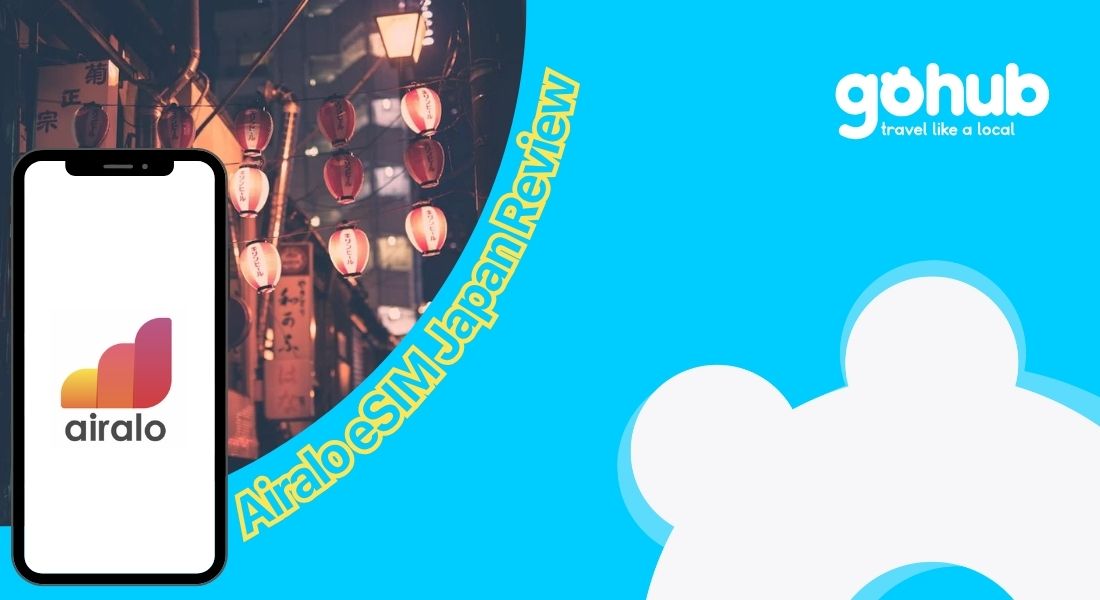Planning a trip to Japan and considering Airalo for your mobile data? You’re not alone. As one of the most popular travel eSIM providers, Airalo has become a go-to for many travelers.
But when it comes to connectivity across Tokyo, Kyoto, and the Japanese countryside, you might be wondering: Is it actually reliable? Easy to use? Worth it? (Curious how it stacks up? See Airalo vs GOHUB.)
In this honest Airalo eSIM Japan review, I’ll break down:
- What Airalo offers in Japan
- My personal experience using it across multiple cities
- Real user feedback on speed, setup, and support
- And whether a newer option—like Gohub Japan eSIM—might offer better value and peace of mind
Let’s dive in before you land at Narita and realize your eSIM isn’t playing nice with your signal
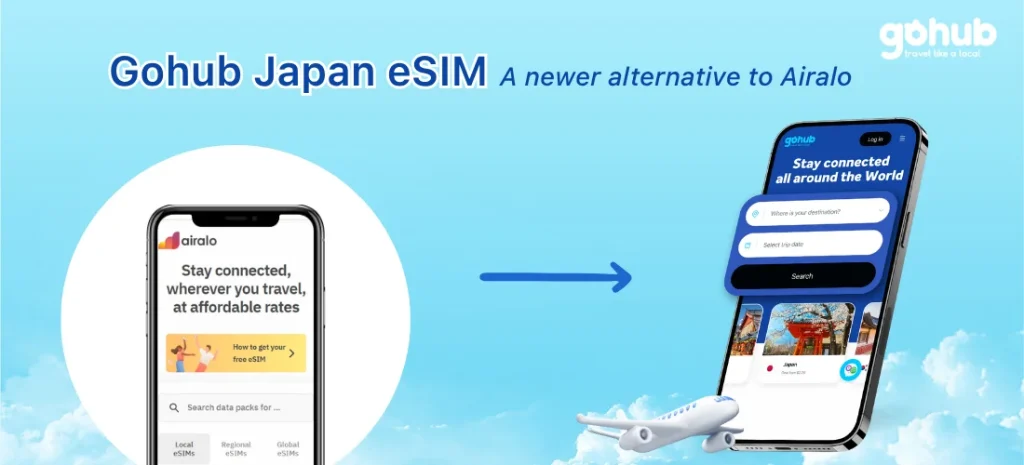
Best Value eSIM for Local Adventures
I. What Airalo Offers in Japan
Airalo offers several eSIM data plans specifically for Japan, available through its app or website. These plans range in price, duration, and data allowance—so whether you’re visiting for 3 days or 3 weeks, you’ll likely find something that fits.
Here’s a breakdown of what you can expect when shopping for a Japan eSIM with Airalo:
Plan Options (as of 2025):
| Data | Validity | Price (USD) |
|---|---|---|
| 1 GB | 7 days | ~$4.50 |
| 3 GB | 30 days | ~$9.50 |
| 5 GB | 30 days | ~$13 |
| 10 GB | 30 days | ~$19 |
| 20 GB | 30 days | ~$26 |
Note: Prices may vary slightly based on currency and promotions.
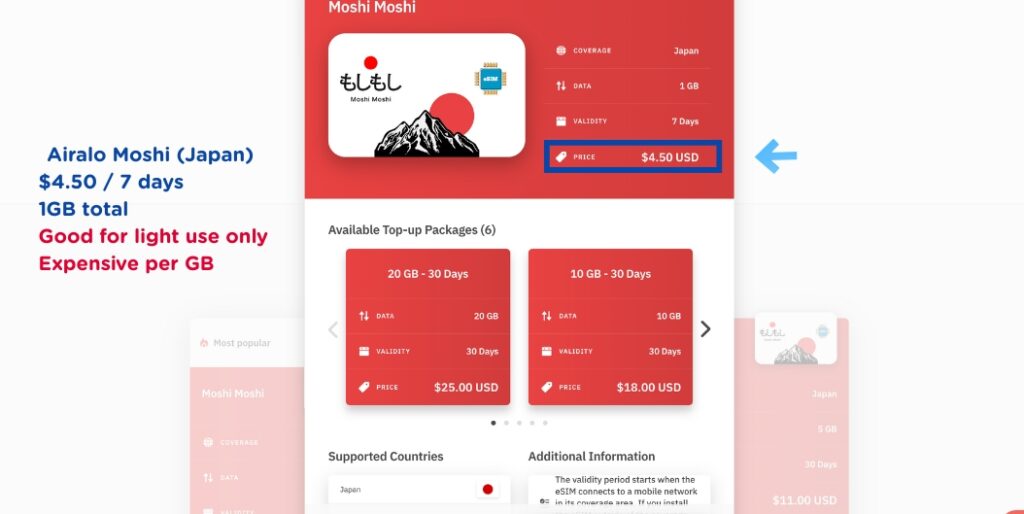
How to Activate an Airalo Japan eSIM
After purchase, you’ll receive:
- A QR code for installation
- Setup instructions (some Android devices require manual APN setup — here’s a guide for Android users)
- Most iPhones (XS and newer) can install directly via camera or through the app
- Activation begins only when your device connects to a local network in Japan
Network Coverage
Airalo Japan eSIMs typically run on NTT Docomo or KDDI/au, two of Japan’s top mobile providers. Coverage is strong in most major cities and transit areas. Some users have reported spotty connections in rural zones or underground stations. Not sure your device is supported? Check the eSIM-compatible devices list before you buy.
If you’re just comparing prices, Airalo may look like a solid deal. But as we’ll explore next in this Airalo eSIM Japan review, real-world performance depends on more than just cost.
II. Pros and Cons of Using Airalo in Japan
Based on user reviews, hands-on tests, and community feedback, Airalo’s Japan eSIM has both highlights and hiccups. Here’s a look at the good—and not-so-good—when it comes to using Airalo during your Japan trip.
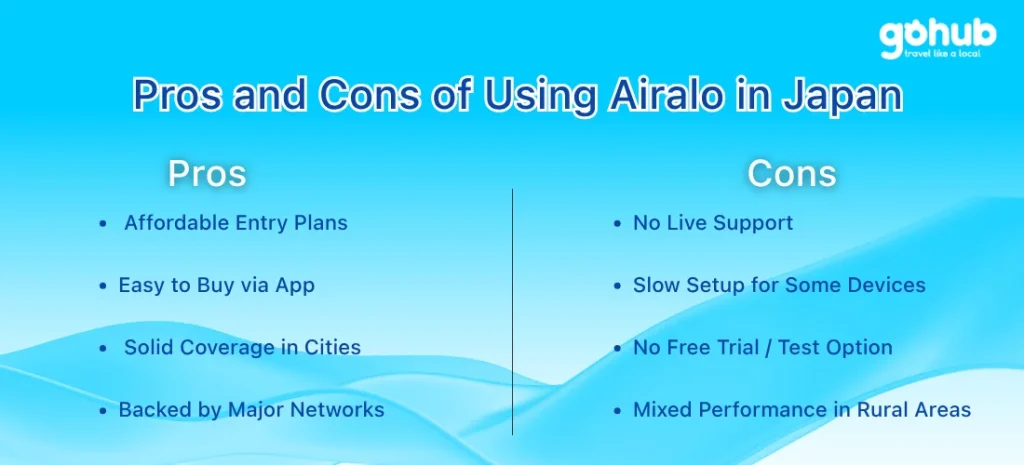
Pros
| Benefit | Why It’s Useful |
|---|---|
| Affordable Entry Plans | Plans start as low as ~$4.50 |
| Easy to Buy via App | Purchase and install from anywhere |
| Solid Coverage in Cities | Works well in Tokyo, Kyoto, Osaka |
| Backed by Major Networks | Runs on NTT Docomo / KDDI infrastructure |
Cons
| Limitation | Why It Might Be an Issue |
|---|---|
| No Live Support | Email-based only; slow replies reported |
| Slow Setup for Some Devices | Manual APN config needed (esp. Android) |
| No Free Trial / Test Option | All purchases are final unless support approves refund |
| Mixed Performance in Rural Areas | Spotty signal in countryside, mountains |
In short:
Airalo works well in Japan’s urban centers, but may fall short if you’re planning to explore off-the-beaten-path areas—or if you value hands-on customer support.
III. My Experience Using Airalo in Japan (Real Trip Example)
I used Airalo’s Japan eSIM during a two-week trip that took me from Tokyo to Kyoto to Osaka—and back again via the shinkansen. I went in expecting plug-and-play simplicity. Here’s what actually happened:
Arrival in Tokyo – So Far, So Good
I installed the Airalo eSIM before my flight. The QR code worked fine, and my phone connected to NTT Docomo almost instantly after landing at Haneda.
Speed was solid in the city—Instagram, Google Maps, and Google Translate all worked without hiccups.
Kyoto – Scenic Temples &… Sluggish Maps
Once I got to Kyoto, I noticed pages took slightly longer to load, especially when I wasn’t near a train station or downtown. Google Maps was… functional, but I wouldn’t rely on it for turn-by-turn in narrow alleys.
Osaka Day Trip – Good Until I Went Underground
In Osaka, speed was fine until I dipped underground on the metro.
My eSIM signal dropped in several stations—enough to make me pull out an old offline map (thank you, 2017 me, for downloading that!)
Support? Well… I Tried
I had a question about whether I could top up my 5GB plan mid-trip. I submitted a support ticket through the app—and got a reply… three days later.
By then, I had already bought another local SIM as backup.
Final Thought?
Airalo did its job—most of the time. But I found myself wanting something a little more:
- Responsive
- Flexible
- And, well… less “hope it works”
Would I use it again? Maybe.
But if there’s a smoother option with better support, I’d switch in a heartbeat.
Real Traveler Feedback: When Airalo Doesn’t Go As Planned
While my experience with Airalo was mostly smooth in major cities like Tokyo and Kyoto, it wasn’t without its frustrating moments—especially in places where signal strength dropped, or when I needed quick support and… got silence.
And it turns out I wasn’t alone.
In a popular thread on Reddit’s r/JapanTravelTips, dozens of travelers shared their real experiences using Airalo across Japan. While many reported positive results, some recurring issues kept popping up—especially in situations where you’d want your data to just work.
Here’s a snapshot of what real users said:
“Airalo was fine… until I went underground in Osaka. Lost signal on the metro.”
— Reddit user
“Worked okay, but data drained faster than other eSIMs I’ve tried. Wouldn’t recommend for longer trips without backup.”
— Reddit user
“Had issues getting signal at Narita Airport. Had to manually change providers. After that, it was fine.”
— Reddit user
“No support, and it made unauthorized purchases.”
— Reddit user (note: this is a rare report, but worth noting)
The takeaway?
Airalo tends to perform well when things go smoothly. But when something goes wrong—like signal dropouts, confusing setup steps, or needing help while you’re out and about—you’re often on your own. No live chat, no in-country support, and refund policies that depend on waiting for email replies.
That’s where GOHUB quietly stands out.
You might not have heard of it yet—and honestly, I hadn’t either before my last trip—but once I tried it, I wondered why it’s not more popular.
Unlike some of the bigger-name eSIM providers, GOHUB doesn’t rely on fancy marketing or flashy branding. What it focuses on is what actually matters when you’re traveling: getting connected quickly, staying connected reliably, and knowing someone’s there to help if anything goes wrong.
The price? It’s noticeably cheaper than Airalo for most plans I compared—sometimes almost half the cost for the same amount of data. The setup? Surprisingly smooth. No QR codes to scan, no digging into settings to configure weird APNs. You just open the app, tap to install, and it works.
What really won me over, though, was the support. The first time I had a question, I opened the chat and an actual human replied within minutes—no chatbot loops, no waiting for an email three days later. It felt like I was talking to someone who actually gets what it’s like to be lost in a train station or trying to check-in to an Airbnb when your map won’t load.
So no, GOHUB isn’t as well-known as Airalo. But if you’re the kind of traveler who values ease, speed, and peace of mind—especially when things don’t go exactly to plan—then GOHUB doesn’t just keep up. In many ways, it’s better.
Sometimes the best travel tools aren’t the ones everyone’s heard of. They’re the ones that quietly do their job so well, you forget you ever worried about it in the first place.
IV. GOHUB Japan eSIM vs Airalo: Why Value Matters More Than Brand
If Airalo felt “good enough,” GOHUB feels like it was built with travelers like us in mind—those who want something affordable, fast to set up, and actually supported by real humans when you need help.
GOHUB might not be as well-known as Airalo (yet), but don’t let that fool you. For the price, it offers an experience that punches far above its weight.
Plans start from just $2.79—sometimes nearly half of what you’d pay on Airalo for the same data. Setup is incredibly straightforward: just install via the app (no QR codes, no manual APNs), and you’re ready to go. If you’ve ever fumbled with QR codes at the airport Wi-Fi lounge, you’ll know how much that simplicity matters.
Support is another area where GOHUB quietly wins. While Airalo users often wait days for email replies, GOHUB offers live in-app chat with human agents, available 24/7. I tested it, and within a minute, I was chatting with someone who answered my question without sending me a knowledge base article or asking me to “submit a ticket.”
As for coverage, GOHUB connects to major networks like SoftBank or KDDI through its regional partners. It’s not tailor-optimized for each region, but in cities like Tokyo, Osaka, and Kyoto, performance is fast and stable. For more remote or mountainous areas, results can vary—similar to Airalo.
There’s no public free trial just yet, but their refund policy is solid if your eSIM doesn’t activate or your phone turns out to be incompatible. Just make sure you reach out early and provide details—they’ll help if it’s a real tech issue.
So while Airalo may be the default name people recognize, GOHUB is the brand that actually listens and delivers better value—especially if you’re price-conscious or want a more human support experience while you travel.
Here’s What Gohub Offers in Japan:
| Feature | Details |
|---|---|
| Price | From $2.79, competitive with Airalo but often with more GB per $ |
| Activation | Instant via app – no QR required, zero guesswork |
| Coverage | Optimized for top carriers in Japan (Tokyo, Osaka, Hokkaido, Nagano) |
| App Experience | Minimalist UI, live data tracking, built for non-techy travelers |
| Support | 24/7 live chat (real humans, not bots) inside the app |
| Free Trial Option | Yes – test before you commit |
| Refund Guarantee | 100% refund if it doesn’t work |
Want curated picks by trip style and budget? Jump to Best eSIM for Japan.
Gohub is especially useful if you:
- Want to land, connect, and go without fiddling with profiles
- Prefer real-time help if something breaks
- Plan to visit multiple cities or even multiple countries in Asia
It’s like the traveler’s version of having a local guide—in your phone.
TL;DR: Gohub’s Japan eSIM puts traveler-first features where they matter most—speed, simplicity, and support.
V. Airalo vs Gohub: Japan eSIM Comparison for 2025 Travelers
If you’re choosing between Airalo and Gohub for your Japan trip, here’s a side-by-side comparison based on what actually matters to travelers in 2025:
| Feature | GOHUB Japan eSIM | Airalo Japan eSIM |
|---|---|---|
| Starting Price | From $2.79 | From ~$4.50 |
| Setup & Activation | Requires QR code setup (guided via app) | QR setup or direct install (on iOS) |
| Support Access | 24/7 live chat (real agents) | Email only (may take 1–3 days) |
| Refund Policy | Refund available for technical issues (with proof) | Case-by-case, not guaranteed |
| Free Trial | Not offered at this time | Not offered |
| Coverage | Uses major Japanese networks (e.g. SoftBank, KDDI) via regional providers | Uses SoftBank or KDDI depending on plan |
| Multi-country Options | Asia regional plans available (manual switching) | Discover+ plan for seamless regional coverage |
| App Experience | Clean UI, easy tracking, beginner-friendly | Functional, with more advanced options |
Quick Verdict:
Gohub gives you more reliability, more support, and more flexibility—especially if you’re traveling beyond Tokyo or combining Japan with other Asia destinations.
VI. Who Should Use Gohub Instead of Airalo in Japan?
Airalo might work for some travelers—but if you fit into any of these categories, Gohub is probably the better eSIM for your Japan trip:
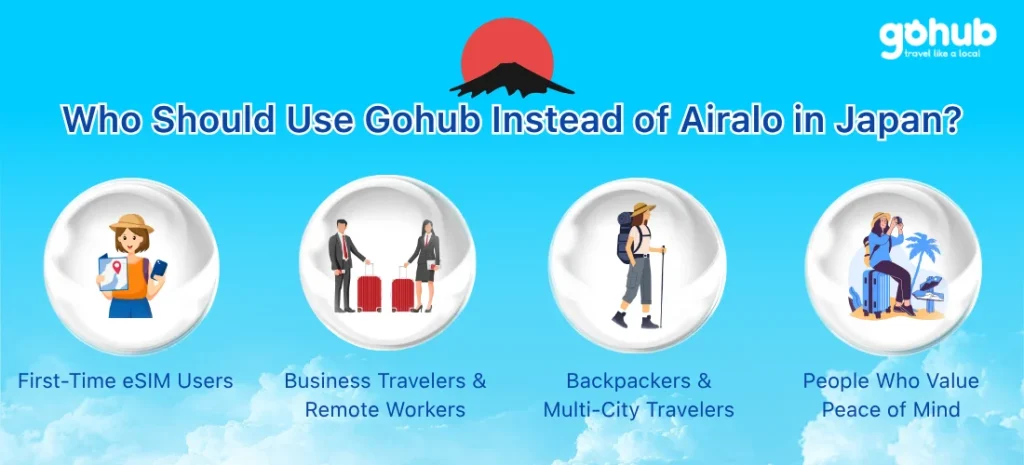
1. First-Time eSIM Users
No QR codes. No tech stress. Just tap, activate, and go.
Learn how to activate eSIM in seconds
2. Business Travelers & Remote Workers
Need to jump on a video call from your ryokan in Kyoto or hotspot on the go?
Gohub gives you fast activation + stable speeds + real-time support if anything breaks.
3. Backpackers & Multi-City Travelers
If you’re hopping from Tokyo → Osaka → Hiroshima → Sapporo, or even continuing to Korea or Thailand, Gohub’s seamless switching and Asia-focused coverage is a lifesaver.
4. People Who Value Peace of Mind
Free trial. Real-time support. Full refund if it doesn’t work.
💬 Talk to support anytime
Gohub gives you:
- Free trial (limited-time)
- 24/7 human chat
- 100% refund if things go wrong
TL;DR: If you want speed, simplicity, and support, Gohub is the Japan eSIM that actually feels like it was built for travelers.
VII. FAQ – Is Airalo eSIM Worth It in Japan?
1. Does Airalo offer eSIMs for Japan?
Yes. Airalo provides prepaid eSIMs for Japan that allow travelers to connect to local networks without buying a physical SIM.
2. How does Airalo’s Japan eSIM work?
After purchase, you’ll receive a QR code. Scan it on your compatible phone, and the eSIM activates once you connect to a Japanese mobile network.
3. Which devices are compatible with Airalo eSIM in Japan?
Most new smartphones including iPhone XS and newer, Samsung Galaxy S20 and newer, and Google Pixel 3 and newer support Airalo eSIM.
4. Does Airalo eSIM in Japan support calls and SMS?
No. Airalo Japan eSIMs are data-only. You’ll need apps like WhatsApp, LINE, or Messenger for calls and messages.
5. How fast is Airalo eSIM in Japan?
Airalo connects to local carriers such as SoftBank and KDDI, offering stable 4G/5G in major cities. However, coverage may be weaker in rural or mountain areas.
6. How much does an Airalo eSIM for Japan cost?
Packages start from just a few USD for short-term data. However, GoHub eSIMs are often cheaper and more flexible for longer stays.
7. Can I recharge or top up my Airalo Japan eSIM?
Yes. You can purchase additional data via the Airalo app, but top-ups tend to be pricier than buying a new plan.
8. Is Airalo the best option for Japan travelers?
Airalo: Good for short-term, light data use.
GoHub: Better for budget-conscious travelers, with up to 50% lower prices, flexible plans, and 24/7 multilingual support.
VII. Final Verdict – Is Airalo the Best eSIM for Japan in 2025?
If you’re only looking for the cheapest possible data plan and plan to stay in Tokyo the whole time, Airalo might be enough.
But for most travelers—especially those exploring beyond big cities, working remotely, or needing real support on the road—Gohub offers a smarter, smoother, more traveler-friendly eSIM experience.
From instant setup and refund guarantees to seamless multi-country coverage across Asia, Gohub was designed to take the stress out of staying connected.
Try Gohub’s Japan eSIM Today
- Plans from $2.79
- One-tap activation (no QR code needed)
- Free trial available
- 24/7 human support
- 100% refund guarantee if it doesn’t work
👉 Download the Gohub App – iOS & Android
Don’t leave your Japan trip up to chance.
Travel smarter with Gohub.
